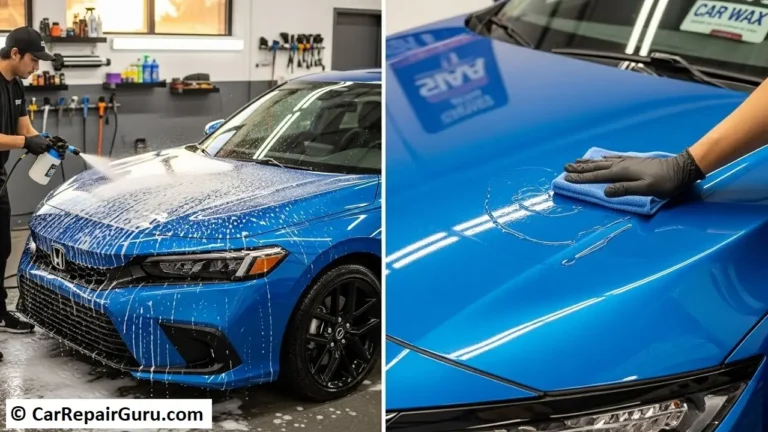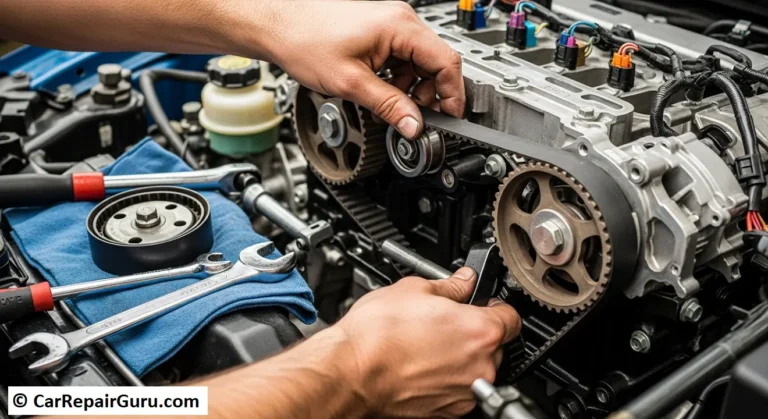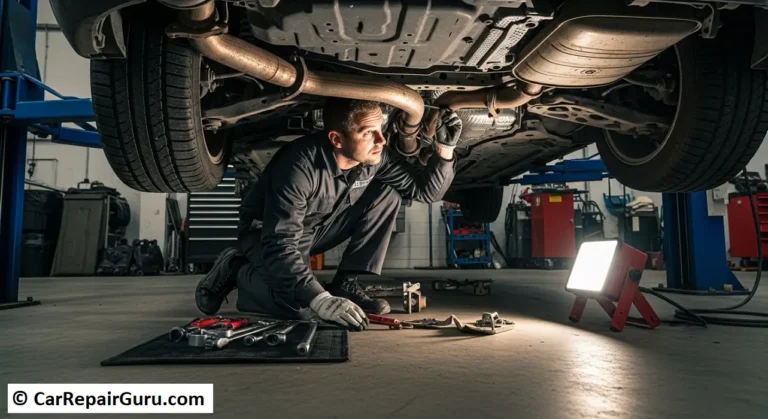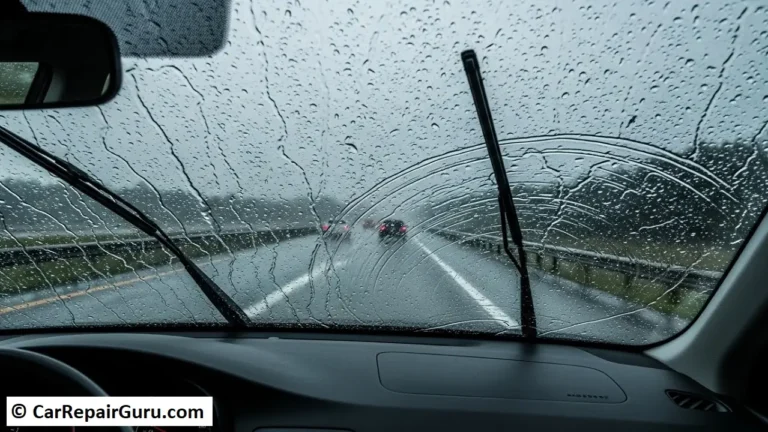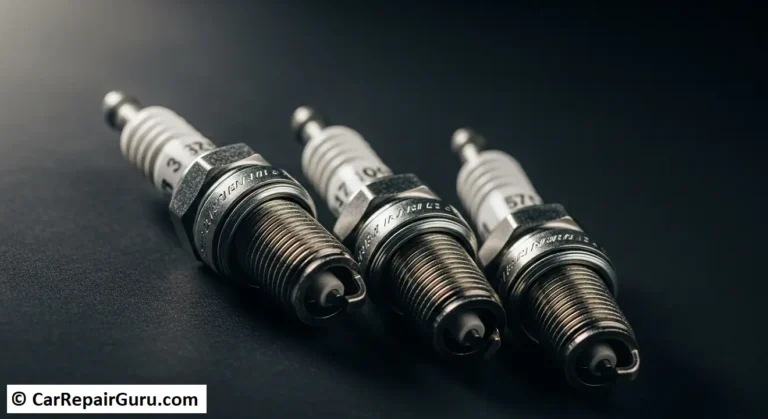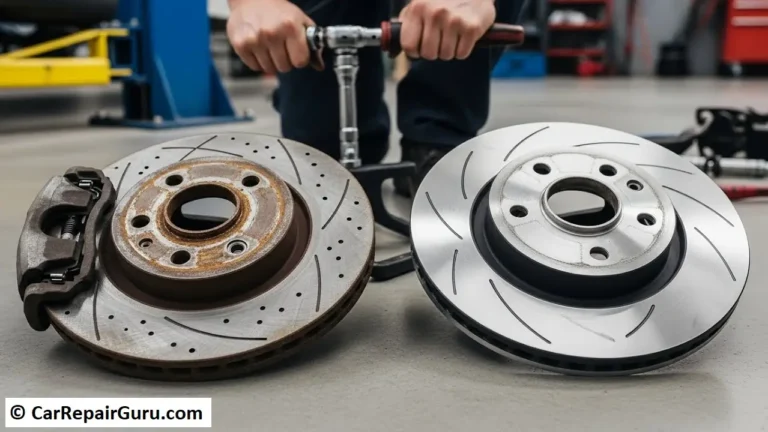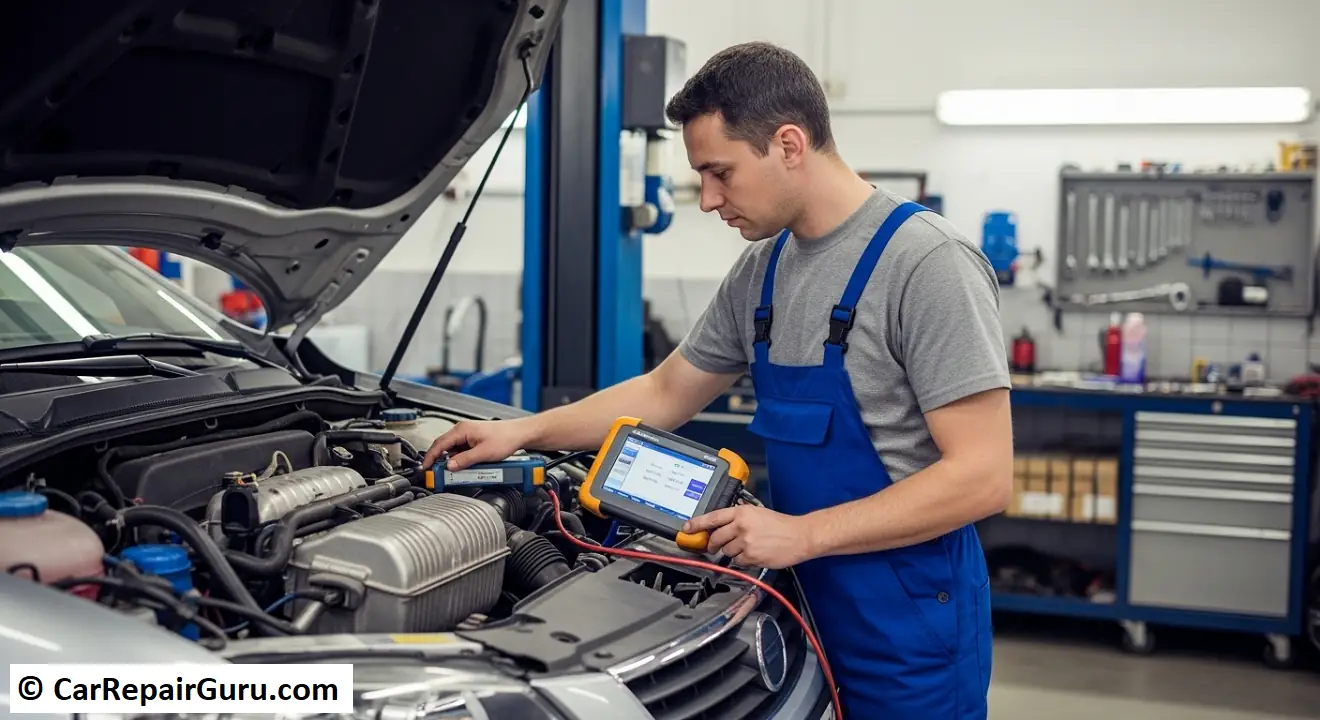
That sinking feeling. You’re driving along, and suddenly, a small, amber light flickers to life on your dashboard: the check engine light. Your mind starts racing. Is this serious? Is my car about to break down? How much is this going to cost?
While that light can signal various issues, one of the most common culprits is your vehicle’s emission control system. But what does that even mean?
Don’t worry. This guide is here to demystify everything. We’ll break down what the emission system is, why it’s so important, the clear warning signs it’s having trouble, and what you can do about it. Consider this your complete roadmap to understanding, diagnosing, and fixing any emission system problems so you can get back on the road with confidence.
Worried about that light on your dash? Let’s figure it out together.
What is a Car’s Emission System and Why Does It Matter?
Think of your car’s emission system as its lungs and liver combined. It’s a complex network of sensors, pipes, valves, and computers all working together to manage and clean up the waste gases your engine produces. Its primary job is to turn harmful pollutants into much less harmful substances before they exit your tailpipe.
A Simple Definition for Every Driver
At its core, the emission control system is responsible for reducing the amount of toxic pollutants—like carbon monoxide (CO), hydrocarbons (HC), and nitrogen oxides (NOx)—that your car releases into the atmosphere. It’s not just one part; it’s a team of components working in harmony.
Here are the key players:
Catalytic Converter: The hero of the system. It uses precious metals like platinum and palladium to convert toxic gases into safer ones like carbon dioxide and water vapor.
Oxygen (O2) Sensors: These are the system’s “noses.” They sniff the exhaust to measure how much unburned oxygen is present, telling the car’s computer whether the engine is running too rich (too much fuel) or too lean (not enough fuel).
EVAP System (Evaporative Emission Control): This system traps gasoline vapors from your fuel tank and lines, preventing them from escaping into the air.
EGR Valve (Exhaust Gas Recirculation): This valve recirculates a small amount of exhaust gas back into the engine to lower combustion temperatures and reduce the formation of NOx.
Mass Airflow (MAF) Sensor: Measures the amount of air entering the engine, helping the computer calculate the right amount of fuel to inject.
The 3 Big Reasons Your Emission System is Crucial
This system isn’t just about passing a test. A healthy emission system is vital for three critical reasons:
- Protecting the Environment: This is the most obvious one. A functioning system dramatically reduces smog-forming pollutants and greenhouse gases, contributing to cleaner air for everyone. (The EPA sets strict standards for this very reason).
- Improving Fuel Economy: The sensors in your emission system are constantly providing feedback to your engine’s computer to optimize the air-fuel mixture. When they work correctly, your engine runs at peak efficiency, saving you money at the pump. A faulty sensor can cause your car to burn more fuel than necessary.
- Ensuring Your Car’s Health: Often, emission system problems are the first sign of a deeper issue. Ignoring them can lead to poor engine performance and, eventually, damage to expensive components like your catalytic converter.
Top 5 Signs You Need an Emission System Check
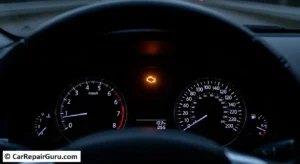
Your car is pretty good at telling you when something is wrong. You just need to know what to look (and listen, and smell) for. Here are the most common signs that it’s time for an emission system check.
1. The Check Engine Light is On: This is the most direct signal. When the onboard computer detects a problem within the emission system—like a sensor reading that’s out of spec or a leak—it illuminates the check engine light to get your attention. It’s the number one reason people come in for a check engine light emission system diagnosis.
2. Failing an Emissions Test / Smog Check: If you live in an area that requires regular emissions testing, a failed test is a clear-cut sign that something is wrong. The testing equipment is highly sensitive and can detect problems even before your check engine light comes on.
3. Reduced Fuel Efficiency: Are you visiting the gas station more often than you used to? A faulty oxygen sensor or mass airflow sensor can throw off your engine’s fuel mixture, causing it to burn through gas much faster.
4. Rough Idling or Stalling: If your car sputters, shakes, or struggles to maintain a steady RPM when you’re stopped at a light, it could be related to a misreading from an emission system sensor. This can lead to an inconsistent fuel supply and poor engine performance.
5. Smell of Gasoline or “Rotten Eggs”: Don’t ignore strange odors. A distinct smell of raw gasoline could point to a leak in the EVAP system. A sulfurous, “rotten egg” smell coming from the exhaust is a classic symptom of a failing catalytic converter that can no longer properly process the sulfur in gasoline.
Common Causes of Emission System Problems (and What They Mean)
So, your check engine light is on and you suspect an emission issue. What’s actually causing it? While a professional diagnosis is the only way to be certain, the problem often traces back to one of these common culprits.
A Loose or Faulty Gas Cap
Yes, really. It’s the simplest fix and a surprisingly common issue. Your gas cap is a crucial part of the EVAP system. If it’s loose, cracked, or the seal is worn out, fuel vapors can escape. The system’s pressure sensor will detect this tiny leak and trigger the check engine light. Always check your gas cap first—make sure it clicks at least three times.
Failing Oxygen (O2) Sensors
Your O2 sensors live a hard life in the hot exhaust stream and eventually wear out. When one fails, it can no longer send accurate information to the engine’s computer. The computer then has to guess how much fuel to use, and it usually guesses wrong. This leads directly to poor gas mileage and a failed emissions test.
A Clogged or Failing Catalytic Converter
This is one of the more serious and expensive emission system repairs. Over time, the catalytic converter can become clogged with carbon deposits or physically damaged. When it fails, it can no longer convert harmful gases effectively. Worse, a clogged converter can create immense backpressure, essentially choking your engine and causing a severe loss of power.
EVAP System Leaks
Besides a loose gas cap, the EVAP system can develop small leaks in its network of hoses, vents, and canisters. These leaks are often tiny and almost impossible to see with the naked eye. They won’t usually affect how your car drives, but they will trigger the check engine light and cause you to fail a smog check.
Malfunctioning Mass Airflow (MAF) Sensor
The MAF sensor tells the computer how much air is coming into the engine so it can add the right amount of fuel. If this sensor gets dirty or fails, it can’t measure correctly. This can cause your car to hesitate during acceleration, idle roughly, and burn through fuel inefficiently.
The Emission System Check Process – DIY vs. Professional
When that check engine light appears, you have a choice: try to figure it out yourself or bring it to a professional.
Can You Check It Yourself?
For the motivated DIYer, there are a few things you can do. First, as we mentioned, check your gas cap.
Beyond that, you can purchase an OBD-II (On-Board Diagnostics) scanner. This device plugs into a port under your dashboard and reads the Diagnostic Trouble Codes (DTCs) stored in your car’s computer. The code (e.g., “P0420”) can point you in the right direction.
However, a code is a clue, not a complete diagnosis. It tells you which sensor detected a problem, but it doesn’t tell you why. A P0420 code often means “Catalyst System Efficiency Below Threshold,” but the cause could be the catalytic converter itself, a failing O2 sensor, or even an exhaust leak.
What Happens During a Professional Diagnostic?
This is where expertise and advanced tools make all the difference. A professional emission system check is far more than just reading a code. Here’s what we do:
1. Advanced Code Scanning: We use professional-grade scanners that not only read the code but also provide live data streams from every sensor in your car.
2. Visual Inspection: Our certified technicians will carefully inspect all visible components of the emission and exhaust systems, looking for cracks, leaks, or damage.
3. Smoke Test: To find elusive EVAP system leaks, we use a smoke machine. This device pumps a harmless, visible vapor into the system. Wherever the smoke escapes is where the leak is hiding.
4. Component Testing: We can test individual components like O2 sensors and EGR valves to confirm they are functioning correctly before recommending a replacement.
5. Clear Diagnosis and Estimate: We put all the pieces together to give you a precise diagnosis of the problem and a clear, no-obligation estimate for the repair.
How to Pass Your Emissions Test – A Proactive Checklist
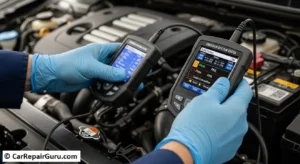
Facing an upcoming smog check? Don’t leave it to chance. Following this simple checklist can dramatically increase your odds of passing on the first try.
Don’t Ignore the Check Engine Light. This is an automatic failure. Get any known issues diagnosed and properly repaired well before your test date.
Get Your Oil Changed. If it’s been a while, get a fresh oil change. Dirty oil can contain contaminants that release more hydrocarbons, potentially pushing you over the limit.
Drive Your Car Beforehand. Don’t take your car for a test after it’s been sitting all night. Drive it for at least 15-20 minutes at highway speeds. This ensures the engine and, most importantly, the catalytic converter are fully warmed up and operating at peak efficiency.
Check Your Tires. Make sure your tires are inflated to the recommended pressure. Some emissions tests are performed on a dynamometer (a treadmill for cars), and proper tire pressure ensures the test is accurate.
Use a Fuel System Cleaner (Occasionally). A quality fuel additive can help clean out carbon deposits from your fuel injectors and intake valves, leading to a cleaner burn.
Understanding Emission System Repair Costs
The cost of an emission system repair can vary wildly depending on what’s wrong, as well as your car’s make and model. Here’s a general idea of what to expect for common repairs:
- New Gas Cap: $15 – $50
- Oxygen Sensor Replacement: $200 – $600
- Mass Airflow Sensor Replacement: $300 – $500
- EVAP Leak Repair: $150 – $700+ (highly dependent on where the leak is)
- Catalytic Converter Replacement: $1,000 – $3,500+ (this is the most expensive common repair due to the precious metals inside)
Your Partner for a Healthy Car and Clean Air
Your car’s emission system is a silent, hardworking hero. It protects our environment, saves you money on gas, and keeps your engine running smoothly. Ignoring the warning signs can lead to failed tests, poor performance, and costly repairs down the road.
Don’t guess what that check engine light means. Let our certified technicians perform a comprehensive emission system check and get you back on the road with peace of mind.
Frequently Asked Questions (FAQ)
How long does an emission system check take?
A basic diagnostic, including reading codes and a visual inspection, can often be done in 30-60 minutes. If more in-depth testing like a smoke test is needed, it may take longer.
Can I drive my car with an emission system problem?
While your car will likely still drive, it’s not a good idea. You will be getting poor fuel economy, releasing excess pollutants, and you risk causing more expensive damage. For example, a misfiring engine can send unburned fuel into the exhaust, which can melt and destroy your very expensive catalytic converter.
Will a new gas cap turn off my check engine light?
If a loose gas cap was the only problem, yes. After tightening it or replacing it, you’ll need to drive the car for a bit (this is called a “drive cycle”). The light should turn off on its own after the computer verifies the problem is fixed.
Why did my car fail the emissions test if the check engine light is off?
This can happen for a couple of reasons. The most common is that the system’s “readiness monitors” are not set. This happens after the battery has been disconnected or codes have been cleared. It means the car hasn’t been driven enough for the computer to verify all systems are working. It can also mean a component is on the verge of failing and its performance is poor enough to be caught by the test equipment, but not bad enough to trigger a light yet.
